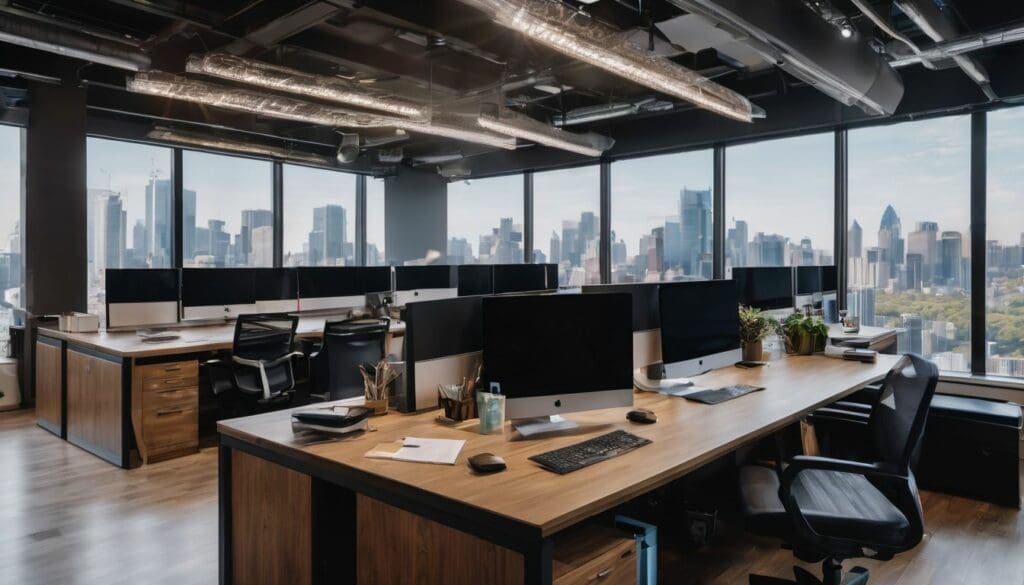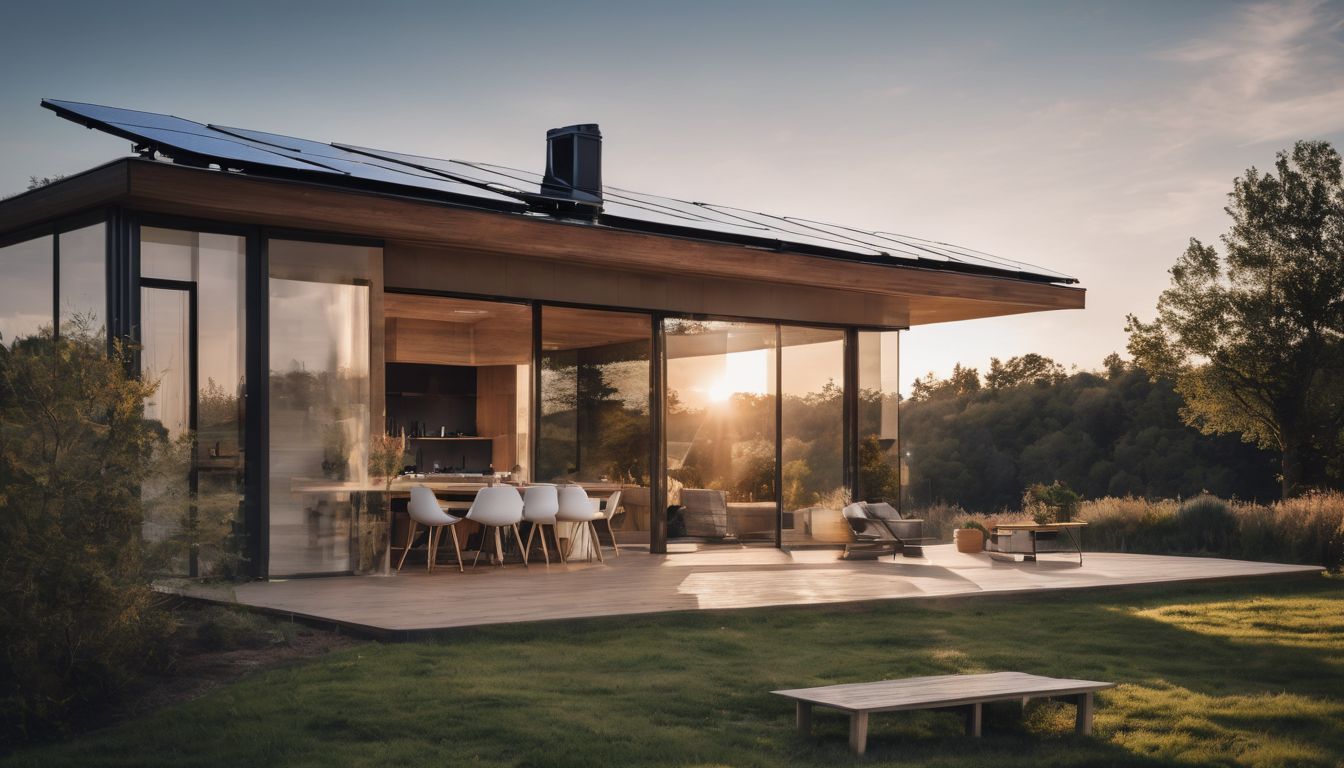Energy bills at work are climbing, and it’s hitting companies hard. Surprisingly, office buildings consume over 20% of the total energy used in the commercial sector in the UK. Our guide offers practical steps to cut down on that usage without cutting corners on your day-to-day operations.
Discover how easy it is to be greener at work; keep reading!
Key Takeaways
- Offices can lower their energy costs and carbon footprint by adopting simple measures like using LED lighting, setting computers to sleep mode, and optimising heating and cooling systems.
- Employee engagement is crucial in reducing workplace energy consumption; encouraging a culture of sustainability can lead to meaningful changes such as turning off equipment after use and utilising natural light.
- Regular maintenance of office equipment not only extends its life but also ensures it operates at peak energy efficiency, further reducing electricity usage.
- Small daily actions like unplugging unused electronics, adjusting temperature settings, and avoiding unnecessary printing can collectively have a large impact on an office’s energy conservation efforts.
- Partnering with companies that prioritise energy efficiency can provide access to new technologies and strategies for cutting down on workplace energy consumption.
Why is Reducing Energy Consumption Important in the Workplace?
Reducing energy consumption in the workplace is important for lower energy costs and reducing the carbon footprint, as well as meeting sustainability goals. By implementing energy-saving initiatives, businesses can contribute to a more sustainable future while also saving money on their electricity bills.
Lower energy costs
Cutting down on energy consumption directly impacts the bottom line by lowering utility bills in the workplace. By adopting energy-efficient practices, companies can see significant cost savings.
Switching to LED lighting, setting computers to sleep mode when not in use, and sealing drafts around doors and windows are straightforward steps that result in immediate savings.
Implementing a sustainable workplace culture drives further reductions in electricity consumption. Encouraging employees to switch off equipment after hours and investing in smart thermostats can make a big difference.
Energy conservation becomes part of daily operations rather than an afterthought, leading to a cycle of continuous improvement and financial benefit without compromising environmental sustainability.
Reducing carbon footprint
Reducing carbon footprint is an essential part of workplace sustainability efforts. By implementing energy-efficient practices and conserving resources, businesses can significantly decrease their environmental impact.
Using renewable energy sources and investing in eco-friendly practices are key steps in reducing carbon emissions, contributing to a healthier planet for future generations.
Implementing sustainable business practices not only benefits the environment but also helps companies save on energy costs. From manufacturing industry energy efficiency to office energy-saving tips, every small effort towards reducing carbon footprint adds up to make a significant positive impact on the environment.
Meeting sustainability goals
By reducing our carbon footprint and implementing energy-efficient practices in the workplace, we actively work towards meeting sustainability goals. This involves adopting environmentally friendly measures to conserve energy, reduce electricity consumption, and lower overall costs.
Embracing eco-friendly practices not only benefits the environment but also aligns with efforts to improve energy efficiency in the workplace, supporting conservation and environmental sustainability.
In addition to practical steps like adjusting lighting and temperature settings and using natural lighting when possible, it’s essential for employees to be engaged in these initiatives.
Identify Energy Saving Opportunities in the Workplace
Take a walk-around the workplace to identify areas for improvement, such as inefficient lighting or outdated equipment. Consider energy-efficient options and involve employees in finding innovative solutions.
Conduct a walk-around to identify areas for improvement
To identify areas for improvement, start by conducting a thorough walk-around of the workplace. Look for opportunities to reduce energy consumption in every area of the facility. Pay attention to lighting, heating, cooling, and equipment usage.
Consider energy-efficient equipment and technology
Implementing energy-efficient equipment and technology is crucial for reducing electricity consumption in the workplace. Upgrading to LED lighting, installing motion sensors, and using smart power strips can significantly cut energy costs and lessen the environmental impact.
Incorporating these technologies not only promotes sustainability but also aligns with conservation measures. Additionally, investing in energy-efficient machinery and appliances contributes to improving overall workplace energy efficiency.
By considering energy-efficient equipment and technology, businesses can embrace eco-friendly practices while simultaneously reducing their carbon footprint. This proactive approach fosters a greener office environment and demonstrates a commitment to energy conservation at work.
Encourage employee participation and engagement
To reduce energy consumption in the workplace, engage employees by sharing energy-efficient practices and involving them in decision-making. Communicate the importance of reducing electricity consumption and seek input for improvement from all staff members.
Encourage a culture where employees feel empowered to suggest and implement cost-saving strategies, therefore fostering an environment conducive to achieving energy efficiency. Energysaving initiatives can be more successful when everyone feels responsible for contributing to the company’s sustainability goals.
Incorporate energysaving practices into day-to-day work habits through training and regular communication on ways to cut energy costs at work. Equip employees with simple techniques like turning off lights when leaving a room or using natural lighting when possible, thus increasing energy efficiency in the workplace through small but effective changes that collectively have a significant impact on reducing the carbon footprint.
Tips for Saving Energy in the Office
Adjust lighting and temperature settings to reduce energy usage, unplug unused electronics, and properly maintain equipment for optimal efficiency. Read on for more tips on reducing energy consumption at work!
Adjust lighting and temperature settings
Consider the impact of adjusting lighting and temperature settings in your workplace to reduce energy consumption. This simple practice can lead to significant savings and contribute to a greener environment. Here are some practical steps you can take:
- Install motion sensors or timers for lighting to automatically turn off when not in use, reducing unnecessary electricity consumption.
- Utilise natural light where possible by positioning workstations near windows and keeping blinds open during daylight hours, lowering the need for artificial lighting.
- Implement smart thermostats to regulate heating and cooling based on occupancy and outside temperatures, maximising energy efficiency.
Unplug unused electronics
- Use power strips to easily turn off multiple devices at once.
- Set up automatic timers for equipment that doesn’t need to be on 24/7.
- Label switches and cords to remind employees to switch off and unplug devices when not in use.
- Implement a workplace policy encouraging employees to unplug devices at the end of the workday.
- Consider investing in smart power strips that cut off power to devices when they’re not in use.
- Educate employees about the benefits of unplugging devices, such as reducing carbon footprint and lowering energy bills.
Properly maintain equipment
To complement the effort of unplugging unused electronics, it is crucial to properly maintain equipment to ensure optimal energy efficiency. Here are some practical tips for maintaining equipment in the workplace:
- Regularly clean and replace air filters in heating, ventilation, and air conditioning (HVAC) systems to improve airflow and reduce energy consumption.
- Conduct routine maintenance on office equipment such as printers, copiers, and computers to prevent energy wastage due to inefficiencies or malfunctions.
- Schedule professional maintenance for machinery and industrial equipment to optimise their performance and minimise energy usage.
- Implement a preventive maintenance programme that includes regular inspections and servicing of all equipment to detect and address potential energy-wasting issues promptly.
- Train employees on proper equipment use and care practices to prolong the lifespan of devices, reduce downtime, and conserve energy.
- Invest in energy – efficient appliances and tools while ensuring they are correctly installed and maintained for maximum efficiency.
- Ensure that all workplace equipment is powered down or set to power – saving modes when not in use to prevent unnecessary energy consumption.
Energy Conservation in Daily Work Habits
Make it a practice to turn off lights when leaving a room, use natural lighting whenever possible, and only print when absolutely necessary. These small changes in daily work habits can make a significant impact on reducing energy consumption in the workplace.
Turn off lights when leaving a room
Turn off lights when leaving a room to conserve energy. It’s a simple and effective way to reduce electricity consumption in the workplace. Encouraging this habit among employees can contribute to lower energy costs and align with sustainability goals, aiding in reducing the overall carbon footprint of the workplace.
By turning off lights when leaving a room, individuals play an active role in practising energy-saving techniques for reducing energy usage in offices or factories. This small change can make a significant impact on improving energy efficiency at work and promoting eco-friendly practices within the office environment.
Use natural lighting when possible
When leaving a room, remember to turn off lights and make the most of natural lighting during the day. Open blinds or curtains to let in sunlight, reducing the need for electric lighting and lowering energy consumption.
This simple habit not only saves electricity but also creates a brighter, more pleasant workspace, promoting an eco-friendly and cost-effective environment. Consider adjusting your workspace layout to maximise access to natural light, boosting energy efficiency and reducing reliance on artificial lighting throughout the workday.
Only print when necessary
To further support energy conservation efforts in the workplace, it’s essential to embrace a “think before you print” mindset. By only printing when necessary, employees can significantly reduce paper waste and lower electricity consumption from printers and related equipment.
Encouraging digital document sharing and reviewing materials on-screen can also contribute to a more eco-friendly office environment.
Implementing a policy of only printing essential documents can lead to substantial cost savings, lessen the reliance on paper products, and ultimately reduce the carbon footprint of the workplace.
Partner with Energy-Efficient Companies
Consider collaborating with energy-efficient companies to enhance your workplace’s sustainability efforts. Stay updated on industry news and developments to maximise energy-saving partnerships.
Consider energy-saving partnerships
To enhance energy efficiency, seek out partnerships with companies that specialise in energy-saving solutions. Collaborating with these experts can provide valuable insights and access to the latest technologies and practices.
By working together, your workplace can benefit from innovative strategies for reducing energy consumption and cutting costs.
Stay informed about industry news and developments to find potential partners who align with your sustainability goals. Building strong relationships with energy-efficient companies can lead to long-term benefits for your workplace’s environmental impact and bottom line.
Stay updated on industry news and developments
To stay informed about the latest industry news and developments in energy-efficient practices, follow reputable environmental websites, subscribe to relevant newsletters, and connect with sustainable businesses on social media.
Engaging with industry leaders can provide valuable insights into new technologies, cost-saving strategies, and innovative energy-efficient solutions for the workplace.
Keeping abreast of energysaving techniques ensures that your workplace remains at the forefront of eco-friendly practices while also staying ahead of regulatory changes and incentives related to reducing electricity consumption.
Conclusion
In conclusion, reducing energy consumption at work is achievable and beneficial. Engaging employees in energy-saving practices can make a significant impact. Implementing simple strategies like adjusting lighting and unplugging electronics can lead to cost savings and environmental benefits.
Partnering with energy-efficient companies can further drive workplace sustainability efforts. Taking these steps will not only reduce energy consumption but also contribute to a greener, more sustainable future for all.
FAQs
1. What are some tips for reducing energy consumption in the workplace?
Incorporate energy-efficient practices such as switching off lights when not needed, using natural light, and setting computers to sleep mode during breaks to cut down on electricity consumption.
2. How can implementing eco-friendly practices at work save money?
Eco-friendly practices like using energy-saving devices and improving insulation can lead to cost-saving strategies by significantly lowering your office’s energy bills.
3. Can employees help with saving electricity in the office?
Absolutely! Employees can contribute to workplace energy efficiency by turning off unused equipment, reporting leaks and draughts, and following energy-saving practices for a green office environment.
4. Is there a way to reduce my factory’s carbon footprint through energy usage reduction?
Yes, factories can reduce their carbon footprint by implementing strategies such as optimising machinery use, conducting regular maintenance checks for efficiency, and exploring renewable energy sources.
5. Why is improving energy efficiency important in the workplace?
Improving energy efficiency not only reduces costs but also contributes towards creating an environmentally responsible business that lowers its overall impact on our planet.





